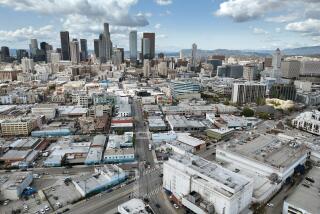Paris’ Building Binge Dazzling but Controversial
- Share via
PARIS — Not since Emperor Napoleon III ordered the reconstruction of Paris in the 1850s, officials boast, has the French capital seen such an explosion of public building.
From the eastern end of Paris to La Defense, the industrial park beyond the city’s western limits, and on both banks of the Seine, a highly controversial program of construction and renovation is costing French taxpayers 30 billion francs (about $5.2 billion). It includes science and art museums, an Arab cultural center, a library and an opera house.
And it’s all been realized since Francois Mitterrand took over as president of France 10 years ago.
“The ‘grands projets’ were considered a presidential fantasy in a country and a capital which had lost the tradition of building ambitious projects,” Dominique Jamet said. “The people were surprised to see the president renewing this practice in the tradition of the kings.”
Jamet is chairman of the commission responsible for the most expensive single project, the Library of France. With groundbreaking scheduled later this year, the library will probably be the last of the grand ventures.
“We’ve perceived two things once the projects are completed. In general, they prove their usefulness, and people are more or less proud to watch Paris move and change and attract so many people,” Jamet says.
But taxpayers grumble that the facilities are too expensive, ill-conceived and sometimes aesthetically jarring amid their more conventional neighbors.
Nothing is sacred--besides a face lift, the Louvre got a pyramid in the middle of its mostly 19th-Century court. No one has escaped the president’s will--the powerful Finance Ministry was exiled from its royal offices in the heart of Paris to a new fortress on the outskirts.
No project has proved too big--the Great Arch at La Defense is as wide as the Champs Elysees and taller than the Notre Dame cathedral. Or too expensive--the Library of France will cost more than $1 billion.
But tourists appear delighted. Visits to the Louvre are up 40% since the glass-and-stainless-steel pyramid entrance opened in 1989. La Villette, with its ultramodern Center for Science and Industry and exhibition halls in the north of Paris, has attracted nearly 5 million visitors a year since it opened in 1986.
And at the white-marble-and-aluminum Great Arch, which houses the Transport Ministry and prominent international companies, about 3,500 visitors ride the glass elevators to the roof each day.
Such success has escaped the $483-million Opera at the Bastille, Paris’ second opera house. Initially it was criticized as redundant, too expensive and inappropriate in design for the Bastille site. Now, nearly two years after its opening, taxpayers are still complaining that it was unnecessary.
Another problem with the grands projets, some say, is that they’re all concentrated in Paris.
There are suspicions too about Mitterrand’s motives. Are these projects critically needed cultural facilities or “Monuments to Mitterrand,” designed to preserve the memory of the first Socialist president since the Fifth Republic was founded in 1958?
That’s a question the French are again asking as the Library of France gets under way amid intense controversy.
Both advocates and critics agree that the present National Library is overburdened. The new facility will offer 4,000 places for library users, compared to the National Library’s 900.
Although the National Library, with its 10.5 million volumes, ranks as a premier library internationally, its budget in recent years has been less than world-class.
While critics applaud politicians for having rediscovered the library, they bemoan the new four-tower design as dangerous for the books and exorbitantly expensive to build and maintain. The L-shaped glass structures will tower nearly 300 feet.
“Will these solar ovens in the form of open books become bonfires consuming the books which France has collected over four centuries?” Mark Fumaroli of the College of France asked in a Le Figaro newspaper article last year.
Other critics, including Patrice Higonnet of Harvard University, say that housing books in towers, especially glass ones, is outdated. Changes in wind and sun hamper climate control. Book stacks, Higonnet says, should be in underground vaults.
Mitterrand, Higonnet contends, is jeopardizing the library’s success by demanding its completion before he leaves office in 1995.
“Mitterrand sees this project as his own masterpiece,” Higonnet wrote in the London Times literary supplement last year. “The project as now conceived should be stopped, and its design resubmitted to a jury mindful of what the settled purpose of the library will be.”
While political analysts snipe at Mitterrand’s policies, it is the grands projets that bedazzle the Parisian cafe-goer, tourist and man in the street.
More to Read
Sign up for Essential California
The most important California stories and recommendations in your inbox every morning.
You may occasionally receive promotional content from the Los Angeles Times.










